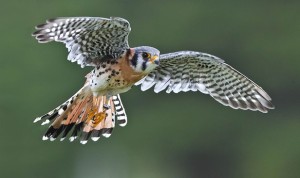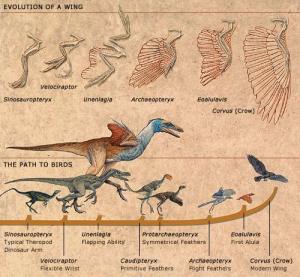One of the things I enjoy saying the most about my experience with wildlife rehabilitation is that I have worked with raptors – birds of prey like owls, hawks, and falcons. They are amazing, interesting birds but I’ll admit that part of that fun is that when people hear “raptor” they often imagine this:
This association is probably partly due to the blockbuster “Jurassic Park” and other dinosaur movies. A major theme of the film, and one that I love as a student of evolutionary anthropology, is demonstration of the bird-dinosaur relationship. The species Compsognathus is described as walking chicken-like, and the final scene of Jurassic Park shows a flock of birds flying from Isla Nublar and the dinosaurs that dwell on it. After Dr. Alan Grant is laughed at for stating that dinosaurs obviously became birds, he retorts with this:
“Well, maybe dinosaurs have more in common with present-day birds than they do with reptiles. Look at the pubic bone: turned backward, just like a bird. Look at the vertebrae: full of airsacs and hollows, just like a bird. And even the word ‘raptor’ means ‘bird of prey.’”
However, this quote implies that there was foresight in the naming of both birds of prey and certain dinosaurs “raptors” because birds are the evolutionary descendants of some dinosaur species. But the way in which language evolves through translation and interpretation means one cannot assume that the naming intentional. And in terms of the history of the knowledge of evolution, this naming was actually more of a coincidence.
The word “raptor” comes from a Latin verb rapere “to seize by force”. Birds of prey are called raptors because of they way they hunt, seizing their prey out of the air, and Websters dictionary first defined birds of prey as raptors in 1823.
The term “velociraptor”, and other species containing the suffix -raptor, probably originated in scientific literature around 1924. They were so named because velox means “swift” and so velociraptors were thought to be speedy predators who seized their prey.
However, both of these groups received their designation as “raptor” long before paleontologists were able to link birds as the descendants of dinosaurs. The evidence of the bird-dinosaur evolutionary lineage was not concretely supported until the 1980s when dinosaur phylogeny was more fully understood with increasing knowledge of genetics, phylogeny, and evolution.
Assuming that the two share a name because they share an ancestor is a false cause logical fallacy, meaning that a false assumption is made when one believes a relationship seen between two things automatically implies one caused the other. In fact birds of prey and some dinosaur species were named before their evolutionary relationship was understood and so their name was more a convenient coincidence of word choice.
If early orinthologists had decided that birds of prey didn’t seize their prey but rather grabbed, snatched, clasped, clutched, or caught them, the Latin translation never would have matched the dinosaur term that came later.



